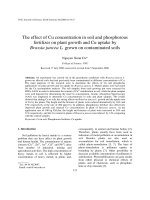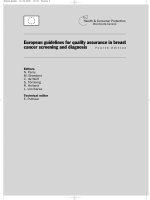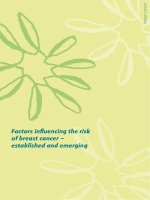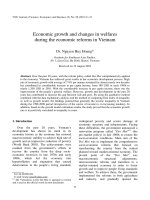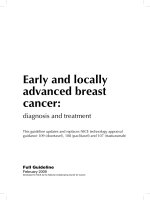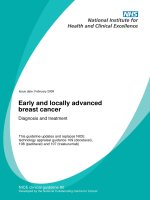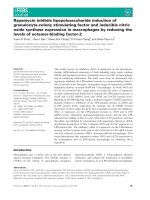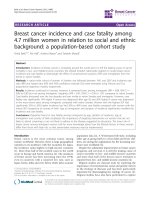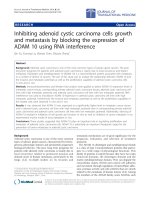Tiamulin inhibits breast cancer growth and pulmonary metastasis by decreasing the activity of CD73
Bạn đang xem bản rút gọn của tài liệu. Xem và tải ngay bản đầy đủ của tài liệu tại đây (5.3 MB, 12 trang )
Yang et al. BMC Cancer (2017) 17:255
DOI 10.1186/s12885-017-3250-4
RESEARCH ARTICLE
Open Access
Tiamulin inhibits breast cancer growth and
pulmonary metastasis by decreasing the
activity of CD73
Xu Yang1†, Shimin Pei1†, Huanan Wang2, Yipeng Jin1, Fang Yu1, Bin Zhou1, Hong Zhang1, Di Zhang1*
and Degui Lin1*
Abstract
Background: Metastasis is the leading cause of death in breast cancer patients. CD73, also known as ecto-5′-nucleotidase,
plays a critical role in cancer development including metastasis. The existing researches indicate that overexpression of
CD73 promotes growth and metastasis of breast cancer. Therefore, CD73 inhibitor can offer a promising treatment for
breast cancer. Here, we determined whether tiamulin, which was found to inhibit CD73, was able to suppress breast cancer
development and explored the related mechanisms.
Methods: We firstly measured the effect of tiamulin hydrogen fumarate (THF) on CD73 using high performance liquid
chromatography (HPLC). Then, we investigated cell proliferation, migration and invasion in MDA-MB-231 human breast
cancer cell line and 4 T1 mouse breast cancer cell line treated with THF by migration assay, invasion assay and activity
assay. Besides, we examined the effect of THF on syngeneic mammary tumors of mice by immunohistochemistry.
Results: Our data demonstrated that THF inhibited CD73 by decreasing the activity instead of the expression of CD73. In
vitro, THF inhibited the proliferation, migration and invasion of MDA-MB-231 and 4 T1 cells by suppressing CD73 activity. In
vivo, animal experiments showed that THF treatment resulted in significant reduction in syngeneic tumor growth,
microvascular density and lung metastasis rate.
Conclusions: Our results indicate that THF inhibits growth and metastasis of breast cancer by blocking the activity of CD73,
which may offer a promising treatment for breast cancer therapy.
Keywords: Breast cancer, CD73, Thf, Metastasis, Angiogenesis
Background
CD73, also known as ecto-5′-nucleotidase, encoded by
NT5E gene, is a widely distributed cell-surface protein
anchored on the plasma membrane via a glycosyl
phosphatidylinositol linkage. CD73 functions via both
enzymatic and nonenzymatic activities in cells [1]. As a
nucleotidase, CD73 catalyzes the conversion of AMP to
adenosine (Ado), a crucial step in the pathway of Ado
generation. Ado binds and activates four Ado receptors:
A1, A2A, A2B and A3 receptors, exerting their various
biological effects [2]. Besides its essential physiological
* Correspondence: ;
†
Equal contributors
1
The Clinical Department, College of Veterinary Medicine, China Agricultural
University, Beijing 100193, China
Full list of author information is available at the end of the article
functions, Ado plays an important role in cancer development. The activities of Ado in cancer include growth
promotion, angiogenesis, immunosuppression, neointimal
hyperplasia and anti-inflammation [1, 3–5]. The activities
of Ado in cancer were mainly achieved by activating Ado
receptors. Via activation of A1 receptor, Ado decreases
p27 expression to up-regulate CDK4 activity, which
results in cell proliferation [6]. Overexpression of A1 receptor has been found in various breast cancer cell lines
and breast tumors [6]. Activation of A2A receptors has
been proven to directly promote tumor cell survival.
Indeed, Etique et al. showed that the activation of A2A
receptor significantly increased the proliferation of breast
cancer cell [7]. Ahmad et al. also reported that the
activation of A2A receptor remarkably enhanced tumor
angiogenesis [8]. In addition, the A2A receptor is a potent
© The Author(s). 2017 Open Access This article is distributed under the terms of the Creative Commons Attribution 4.0
International License ( which permits unrestricted use, distribution, and
reproduction in any medium, provided you give appropriate credit to the original author(s) and the source, provide a link to
the Creative Commons license, and indicate if changes were made. The Creative Commons Public Domain Dedication waiver
( applies to the data made available in this article, unless otherwise stated.
Yang et al. BMC Cancer (2017) 17:255
suppressor of endogenous tumor immunity. Ohta et al.
revealed that A2A receptor inhibition enhanced existing
antitumor immune responses [9]. Ado also promotes cell
proliferation, dissemination and angiogenesis by activating
A2B receptor. The activation of the A2B receptor has
been shown to enhance cell proliferation in prostate
cancer cell lines [10]. The blockade of A2B receptor slows
growth of bladder and breast tumors. Stagg et al.
demonstrated the ability of adenosine to increase tumor
cell migration and metastasis via binding to A2B receptor
[11]. Besides, the activation of A2B receptor induces the
production of IL-4, IL-8, IL-13 and vascular endothelial
growth factor [12]. Adenosine also regulates tumor cell
proliferation through A3 receptors [13–15]. As a key
enzyme in the generation of Ado, CD73 plays a critical
role in cancer development. In addition to its function
elicited by the production of Ado, CD73 is involved in the
promotion of cancer directly. CD73 could mediate cancer
invasive and metastatic properties by regulating cell interaction with extracellular matrix (ECM) components, like
laminin and fibronectin [16, 17]. Actually, both enzymatic
and nonenzymatic functions of CD73 are associated with
cancer progression and not completely independent of
each other [18]. Overexpression of CD73 could facilitate
malignant behaviors of carcinomas, such as growth, adhesion, migration, invasion and metastasis [19]. Recently,
CD73 overexpression has been reported in many types of
human and mouse cancers, including breast cancer [11,
19], gastric cancer [20], pancreatic cancer [21], colorectal
cancer [22, 23], prostate cancer [24] and thyroid cancers
[25]. The vital role of CD73 in cancer development has
been highlighted.
Breast cancer is the second most common cancer
worldwide and, by far the most frequent cancer in women,
comprising about a quarter of all female cancers, as well
as a leading cause of cancer death in women [26]. In
breast cancer, tissue invasion and metastasis is the most
happened outcome resulting in lethal. It is very meaningful to understand the molecular mechanisms involved in
breast cancer and find more effective treatment target site
[27]. In breast cancer, CD73 overexpression is associated
with a highly aggressive cancer phenotype, tumor promotion, and drug resistance [11]. Inhibition of CD73 can
suppress cell growth, invasion in breast cancer and reduce
tumor growth and metastasis [11, 28]. Targeted cancer
therapy is supposed to be more effective than conventional treatments and less harmful to normal cells. AntiCD73 targeted therapy may offer a promising treatment
for breast cancer containing high level of CD73.
In our study, we found tiamulin, used in the form of
tiamulin hydrogen fumarate (THF), could inhibit the
activity of CD73. Tiamulin is a derivative of the tricyclic
diterpenoid compound pleuromutilin, a product isolated
from the Clitopilus scyphoides [29]. Pleuromutilins inhibit
Page 2 of 12
targeted protein synthesis by interfering with the large
subunit of the bacterial ribosome. Tiamulin, as an antibiotic, is mainly used to treat dysentery and respiratory
diseases in veterinary medicine [29]. Ronald N. Jones etc.
also reported that tiamulin remained antimicrobial activity
against anaerobes, intestinal spirochetes, and many common isolates of staphylococci and streptococci from animal
and human [30]. Tiamulin is widely used in the form of
THF. In this paper, based on its function of inhibiting
CD73, THF was firstly studied as a targeted anti-tumor
medicine in breast cancer, which was never reported
before in the light of our knowledge.
Methods
CD73 activity inhibition in vitro
In this assay, all reagents including tiamulin hydrogen
fumarate (THF), Adenosine monophosphate (AMP) and
Adenosine (Ado) were purchased from Sigma-Aldrich
(St Louis, MO, USA), except Recombinant Human 5′Nucleotidase/CD73 Protein (rhCD73) (R&D Systems,
MN, USA). CD73 activity was analyzed by measuring
the conversation of AMP to Ado with high performance
liquid chromatography (HPLC) system (Agilent Technologies Inc., CA, USA). Briefly, rhCD73 (100 ng/mL)
was prepared in assay buffer (25 mM Tris, 5 mM
MgCl2, pH 7.5). Then, assay buffer alone (control) or
with THF (5, 10 or 20 μM) was added. After 10 min,
AMP (100 μM) was added for an additional 10 min. The
production of Ado was detected by HPLC at 254 nm,
and CD73 activity was expressed as Ado production per
mg protein in 10 min. As well as THF, α, β-Methylene
adenosine-5′-disphosphate (APCP, a specific inhibitor of
CD73) (10 μM) or tylosin (an antibiotic similar to THF
in antibiotic spectrum) (10 μM) was used in this assay as
positive or negative control.
Cell culture
In this study, the human breast cancer line MDA-MB-231
and the mouse breast cancer line 4 T1 purchased from
American Type Culture Collection (ATCC, Manassas, VA,
USA) were used. MDA-MB-231 was cultured in DMEM
medium (gibco, life technologies, NY, USA) supplemented
with 10% fetal bovine serum (FBS) (gibco, life technologies) and penicillin-streptomycin (100 units/mL). 4 T1
was cultured in RPMI 1640 medium (gibco, life technologies) supplemented with 10% FBS and penicillinstreptomycin (100 units/mL). Both cell lines were cultured
in a humidified atmosphere of 5% CO2 at 37 °C.
Cell proliferation evaluation
Cell viability was analyzed using a Cell Counting Kit-8
(CCK-8) (Beyotime, Jiangsu, China). MDA-MB-231 or
4 T1 cells were seeded in 96-well plates at 2 × 104 cells
per well and incubated overnight before attached. Then,
Yang et al. BMC Cancer (2017) 17:255
cells were treated without (control group) or with different concentrations of THF (0, 6.25, 12.5, 25, 50 or
100 μg/ml). After 0, 12, 24, 36 or 48 h, cell viability was
assessed with CCK-8 according to the manufacturer’s instructions. To determine the cell viability, the optical
density (OD) values were measured at 450 nm using a
microplate reader (Bio-Rad, CA, USA). Cell proliferation
was determined as a percentage of the control wells.
In the colony formation assay, MDA-MB-231 or 4 T1
cells in single-cell suspension with solvent alone (control)
or different concentrations of THF (12.5 or 25 μg/mL)
were seeded in 12-well plates at a density of 2000 cells per
well. After 24 h treatment, the cell debris and unattached
cells were washed out and fresh medium without THF
were added into each well. After 7 days of incubation,
colonies were fixed with methanol and stained with 0.1%
crystal violet (Solarbio, Beijing, China). Visible colonies
(>50 cells/colony) in the wells were manually counted and
compared.
CD73 activity in cells
The CD73 activity assay was performed as described by
Sherene Loi et al. [31]. MDA-MB-231 or 4 T1 was
plated at 104 cells per well in a 96-well plate and
cultured in complete medium. After 24 h, culture
medium was removed and cells were washed twice with
prewarmed phosphate-free assay buffer (2 mM MgCl2,
125 mM NaCl, 1 mM KCl, 10 mM glucose, 10 mM
Hepes pH 7.2, diluted in ddH2O). THF (12.5 or 25 μg/
mL) diluted in assay buffer or buffer alone (control) was
added to cells and incubated at 37 °C for 10 min. AMP
(250 μM) diluted in assay buffer or buffer alone was then
added and incubated at 37 °C for 1 min. Phosphate
concentrations resulting from AMP hydrolysis by CD73
were measured using the malachite green phosphate
detection kit (R&D Systems, MN, USA) following the
manufacturer’s instructions. For further confirmation,
THF, as well as APCP or tylosin (25 μg/mL), was tested
again in this assay.
Western-blot
Western-blot analysis was used to detect the expression
of CD73 protein in MDA-MB-231 and 4 T1 cells. Cells
were randomly plated in a 6-well plate and treated with
THF (12.5 or 25 μg/ml) or solvent alone (control). After
36 h, cells were collected and lysed, and then proteins
were isolated and quantified using the BCA protein
assay kit (Beyotime, Jiangsu, China). Twenty micrograms
of each sample were separated by 10% SDS-PAGE,
transferred to PVDF membranes (MercK Millipore, MA,
USA). The membranes were blocked in 5% milk for 2 h
and incubated with primary antibody against CD73
(Abcam, Cambridge, USA) or GAPDH (Santa Cruz
Biotechnology, CA, USA) (as loading control) overnight,
Page 3 of 12
followed by secondary antibodies for 2 h, and then
detected by enhanced chemiluminescence detection
reagent (Millipore Corporation, MA, USA).
Cell migration and invasion assays
In the cell migration and invasion assays, a 24-well transwell plate (lower chamber) and transwell inserts (upper
chamber) with 8 μm pore size polycarbonate membrane
(Corning Incorporated, NY, USA) were used. In the migration assay, MDA-MB-231 or 4 T1 cells (5 × 104/mL) in
100 μL serum-free media with solvent (control) or different
concentrations THF (12.5 or 25 μg/mL) were added to the
upper chamber, meanwhile the lower chamber was filled
with 600 μL media containing 10% FBS. After 36 h of incubation, tumor cells in the upper chamber were removed
carefully. The cells that migrated through the membrane to
the lower surface were fixed with methanol, stained with
0.1% crystal violet. Cell numbers were counted as the
means ± SD of cells in five separate views based on three
independent experiments. In the invasion assay, 5 × 103
cells in 100 μL serum-free media were added to the upper
chamber, which was precoated with 30 μg Matrigel Matrix
(Corning Incorporated). The lower chamber was filled with
600 μL media containing 10% FBS. After 36 h of incubation, Matrigel Matrix and cells in the upper chamber were
removed carefully, and then cells adhering to the lower
surface of the membrane were counted. To investigate the
relevance of the inhibition effects of THF on CD73 activity
to tumor migration and invasion, exogenous Ado was
added to THF treatment groups in parallel experiments.
Animal experiment
Four-week old female BABL/c mice used in this study
were purchased from Vital River (Beijing, China). After a
week of acclimatization, 4 T1 cells (1.5 × 106) suspended
in 100 μL PBS or PBS alone (normal control) were
injected subcutaneously into the right flank of each
mouse. After 5 days, tumor bearing mice were randomized into positive control, low-dosage and high-dosage
groups (6 mice in each group). By intragastric administration once per day, the mice in normal and positive
control groups were treated with solvent alone; those in
low-dosage and high-dosage groups were treated with
low-dose (80 mg/kg body weight) and high-dose
(160 mg/kg body weight) THF, respectively. Meanwhile,
body weights and tumor volumes were regularly monitored during the course of treatment. Tumor volumes
were calculated as height × width 2/2. After 21 days of
treatment, mice were sacrificed for collections of
syngeneic tumors and lung tissues. All animal
procedures were performed with the approval of the Institutional Animal Care and Use Committee of China
Agricultural University.
Yang et al. BMC Cancer (2017) 17:255
Immunohistochemistry
After removed from the mice, the syngeneic tumors and
lung tissues were fixed with neutral-buffer formalin,
embedded in paraffin wax and sectioned serially at 4 μm.
Immunohistochemistry (IHC) staining was performed by
using antibodies for the proliferation marker protein Ki-67
(anti-Ki67) (mouse monoclonal, ZSGB-BIO, China), cluster
of differentiation 31(anti-CD31) (rabbit polyclonal, Bioss,
China). After incubated with biotinylated secondary antimouse or anti-rabbit antibody IgG (ZSGB-BIO, Beijing,
China), tissue sections were firstly developed with 3, 3′-diaminobenzidine (DAB) and then counterstained with
hematoxylin. After dehydrated and mounted, the staining
tissues were observed under a microscope and analyzed by
Image-pro-plus (IPP) software (Media Cybernetics,
Washington, USA).
Statistical analysis
All experiments were performed in three independent
experiments and results are expressed as mean ± standard
Page 4 of 12
deviation (SD). The results are analyzed using SPSS 20
software (Statistical Product and Service Solutions,
Chicago, USA). The analysis of one-way ANOVA or
Student’s t-test (when only 2 groups) was used to identify the differences between groups. P < 0.05 was
regarded as statistically significant.
Results
CD73 activity was significantly decreased by THF
To investigate the effect of THF on CD73 activity, we
assessed the ability of CD73 to converse AMP to Ado
using HPLC. Fig. 1a was a representative HPLC chromatograph. In control group, the production of Ado by
CD73 was 79.54 ± 3.69 nM/mg protein/10 min (Fig. 1b).
However, the productions of Ado with the treatment of
5, 10 and 20 μM THF were significantly decreased by
47.37%, 68.95% and 85.67% (Fig. 1b), respectively. The
production of Ado was also significantly decreased by
APCP treatment but not by tylosin treatment (Fig. 1b).
Fig. 1 THF decreased the activity of CD73. a Representative high performance liquid chromatography (HPLC) of AMP and Ado in control and
THF treatment group. The absorbance was detected by UV at 254 nm. b CD73 enzyme activity was expressed as Ado productions per mg
protein in 10 min. Data represent the mean ± S.D. of three independent experiments. Peak identities were confirmed by comparing the UV
spectra and retention times of samples with standard compounds. Ado productions were obtained by comparing the peak area of samples with
standard. (**P < 0.01, ***P < 0.001 vs. control)
Yang et al. BMC Cancer (2017) 17:255
These data demonstrated that THF had a remarkable
effect on decreasing the activity of CD73 in vitro.
Cell proliferation decreased dramatically after treatment
with THF
To determine the effect and doses of THF, we detected
the cell vitalities of MDA-MB-231 and 4 T1 cells using
CCK-8. The results (Fig. 2a and b) showed that the cell
vitalities of both cell lines decreased with increasing
dose or treatment period. THF exhibited its effect in
clear dose- and time-dependent manners. In the colony
formation, the ability of cell colony was evaluated.
MDA-MB-231 cells and 4 T1 cells were treated with
THF, and then stained with crystal violet. Representative
staining results were shown in Fig. 2c. With the treatment of 12.5 μg/mL THF, the number of colonies was
reduced by 67.83% in MDA-MB-231 cells and 63.06% in
4 T1 cells (Fig. 2d). When the treatment doses increased
to 25 μg/mL, the reduction reached to 87.59% in MDAMB-231 cells and 83.41% in 4 T1 cells (Fig. 2d). Our
data showed that THF dramatically inhibited colony
formation of both cells.
THF inhibited CD73 by down-regulating the activity
instead of the expression of CD73
To further explore the mechanisms involved in the effect
of THF on CD73, we measured the activity and expression
of CD73 in MDA-MB-231 and 4 T1 cells. Compared with
the controls, THF treatment significantly decreased the
activity of CD73 in both cells in a dose dependent manner
(Fig. 3a and b). At the concentration of 12.5 μg/mL, THF
Page 5 of 12
inhibited the activity of CD73 by 53.89% in MDA-MB-231
cells (Fig. 3a) and 31.41% in 4 T1 (Fig. 3b). Increased the
concentration to 25 μg/mL, the inhibition rate reached to
70.53% in MDA-MB-231 cells (Fig. 3a) and 51.89% in
4 T1 (Fig. 3b). Similar inhibitions were achieved by APCP
treatment but not by tylosin treatment in both cell lines
(Additional file 1: Figure S1). Next, western-blot was used
to determine the effect of THF on CD73 expression in
MDA-MB-231 and 4 T1 cells. As shown in Fig. 3c and d,
THF almost didn’t affect the expression of CD73 in both
of these two cells. Together, the results above suggested
that THF primarily exerted its effect by down-regulating
the activity instead of the expression of CD73.
THF suppressed cell migration and invasion via CD73
inhibition
Ado produced by CD73 promotes cell migration and invasion, which are central in cancer metastatic process. In the
migration assay, THF treatment caused a significant
decrease in the amount of migrated cells. THF showed
clear dose dependency in both MDA-MB-231 and 4 T1
cells (Fig. 4a). At the concentration of 12.5 μg/mL, THF
inhibited cell migration by 48.31% in MDA-MB-231 and
27.86% in 4 T1 (Fig. 4b). When the concentration increased to 25 μg/mL, the inhibition rate reached to
76.20% in MDA-MB-231 and 67.01% in 4 T1 (Fig. 4b).
However, the inhibition was rescued by adding Ado in
both cells (Fig. 4c). Compared to the THF alone treatment
group, the treatment of Ado (50 μg/mL) significantly increased the number of migrated cells in both cell lines.
And, THF didn’t significantly decrease cell migration in
Fig. 2 Cell viability decreased after treatment with THF. Cell viability was tested using Cell Counting Kit 8 at 0, 12,24,36,48 h after treatment with
0, 6.25, 12.5, 25, 50, 100 μg/mL THF in (a) MDA-MB-231 and (b) 4 T1 cells. Cell vitalities of both cells decreased with increasing dose or treatment
period. c Representative colony formation of MDA-MB-231 and 4 T1 cells after treatment with solvent or 12.5, 25 μg/mL THF. THF significantly
inhibited colony formation of both two cells (d). Data represent the mean ± S.D. of three independent experiments. (***P < 0.001 vs control)
Yang et al. BMC Cancer (2017) 17:255
Page 6 of 12
Fig. 3 THF inhibited CD73 by down-regulating the activity instead of the expression of CD73. a and b Effect of THF on CD73 activity in breast
cancer cells. After treatment with THF (12.5 or 25 μg/mL), CD73 activity significantly decreased in (a) MDA-MB-231 and (b) 4 T1 cells. c and d
Western Blotting showing the expression of CD73 after 36 h treatment with solvent or 12.5, 25 μg/mL THF. Similar results were obtained from
independent experiments in (c) MDA-MB-231 and (d) 4 T1 cells. Data represent the mean ± S.D. of three independent experiments. (*P < 0.05,
**P < 0.01 vs control)
Ado treatment groups compared to the control (Fig. 4d)
(P > 0.05).
Next, cell invasion was tested in MDA-MB-231 and
4 T1 cells (Fig. 5a and c). Similar to the results in the
migration assay, THF treatment significantly decreased
cell invasion in both cells (Fig. 5b), while THF didn’t
cause significant decreases of cell invasion in Ado treatment groups compared to the control (Fig. 5d).
Together, these results suggested that THF inhibited cell
migration and invasion through down-regulation of
CD73 activity.
THF inhibited syngeneic tumor in vivo
Since THF suppressed cell proliferation of cancer cell
lines in vitro, we supposed it will further inhibit tumor
growth in vivo. To confirm it, 4 T1 cells suspended in
Fig. 4 THF inhibited cell migration by decreasing CD73 activity. a Cells were cultured with solvent or 12.5, 25 μg/mL THF onto the upper well. After
36 h treatment, cells passed through the membrane into the lower well were stained and counted (Scale bar =25 μm). b Analysis of cell migration
between control and THF treatment groups corresponding to the images in a. c In parallel experiments, exogenous Ado was added in THF treatment
groups. After 36 h treatment, cells passed through the membrane into the lower well were stained and counted (Scale bar =25 μm). d Analysis of cell
migration between control and treatment groups corresponding to the images in c. Data represent the mean ± S.D. of three independent
experiments. (*P < 0.05, **P < 0.01, ***P < 0.001 vs control)
Yang et al. BMC Cancer (2017) 17:255
Page 7 of 12
100 μL PBS or PBS alone (normal control) were injected
subcutaneously into female BABL/c mice to establish
syngeneic tumors. Then the mice were treated once per
day with 80 or 160 mg/kg THF by oral gavage. After 21day treatment, all syngeneic tumors were collected (Fig.
6a). Quantitative analysis exhibited that the volume and
weight of tumors in both treatment groups were significantly less than those in control group (Fig. 5b and c).
Next, immunohistochemistry staining of Ki67 was performed in tumor tissues (Fig. 6d). The levels of Ki67 in
treatment groups were significantly decreased compared
to those in control (Fig. 6e). The data further confirmed
that tumor growth was synergistically inhibited by THF.
those in the control group(24.08 ± 1.78) (Fig. 7c and d).
All these data demonstrated that THF inhibited pulmonary metastasis of 4 T1 tumor in vivo.
To further explore the mechanism involved in the
inhibition of tumor by THF, we detected the expression
of CD31 (a biomarker of angiogenesis) in primary tumor
tissues by IHC staining (Fig. 7e). After semi quantitative
analysis, the data showed that the level of CD31 in lowor high-dosage treatment groups significantly decreased
compared to those in the control group (0.20 ± 0.02 or
0.12 ± 0.02 vs. 0.34 ± 0.03) (Fig. 7f ). These suggested
that the antitumor effect of THF via inhibition of CD73
also led to angiogenesis reducing.
The antitumor effect of THF resulted in inhibition of
metastasis and angiogenesis
Discussion
CD73 is overexpressed in various types of cancer including
breast cancer, gastric cancer, pancreatic cancer, colorectal
cancer, prostate cancer and thyroid cancers [11, 19–25]. Increasing evidences have verified that CD73 plays a key role
in cancer development, and CD73-derived Ado is also a
crucial immunosuppressive factor, which promotes cancer
progression including growth and metastasis [32, 33]. In
breast cancer, CD73 overexpression was significantly associated with a worse prognosis, particularly in triple negative
breast cancer (TNBC) [31]. Moreover, CD73 was deemed
to be associated with resistance to antitumor agents. CD73
expression was revealed to be involved in an increased resistance to doxorubicin (DOX) in TNBC [31]. Particularly,
due to the satisfactory effect on tumor-bearing mouse
Unlike other mouse models of breast cancer, 4 T1 tumor
can cause severe lung metastasis. As THF significantly
inhibited the growth of primary tumors, we detected
several indicators of pulmonary metastasis in all groups.
Complete lungs were fixed after the autopsy and the
number of metastatic foci (arrow) was counted (Fig. 7a).
As show in Fig. 7b, the numbers of metastases in both
low- and high-dosage treatment groups (48.83 ± 6.78
and 19.83 ± 4.26, respectively) were significantly less
than those in the control group(76.67 ± 5.62). Besides,
the IHC staining of Ki67 of lung tissues in both lowand high-dosage treatment groups (14.81 ± 1.65 and
7.83 ± 1.07, respectively) were significantly less than
a
b
*
***
***
c
***
d
Fig. 5 THF inhibited cell invasion by decreasing CD73 activity. a Cells were cultured with solvent or with 12.5, 25 μg/mL THF onto the upper
well. After 36 h treatment, cells passed through the Matrigel into the lower well were stained and counted (Scale bar =25 μm). b Analysis of cell
invasion between control and THF treatment groups corresponding to the images in a. c In parallel experiments, exogenous Ado was added in
THF treatment groups. After 36 h treatment, cells passed through the Matrigel into the lower well were stained and counted (Scale bar =25 μm).
d Analysis of cell migration between control and treatment groups corresponding to the images in c. Data represent the mean ± S.D. of three
independent experiments. (*P < 0.05, **P < 0.01, ***P < 0.001 vs control)
Yang et al. BMC Cancer (2017) 17:255
Page 8 of 12
Fig. 6 THF inhibited syngeneic tumor growth in vivo. Mice were injected s.c. with 1.5 × 106 4 T1 cells and then treated daily with THF at 80 or
160 mg/kg by gavage for 21 consecutive days. a The anatomic morphologic observation of syngeneic tumors in control and treatment groups.
Tumor volume (b) and tumor weight (c) was calculated at indicated time points after treatment. d Representative Ki67 IHC staining of control or
treated tumor tissues from mice (Scale bar =25 μm). e Quantitative analysis of Ki67 staining corresponding to the images in d. Data represent the
mean ± S.D. of three independent experiments. (*P < 0.05, **P < 0.01, ***P < 0.001 vs control)
models, although there’s still a long way to go in clinical
practice, anti-CD73 therapy has become a promising treatment for cancer patients in the future [34, 35].
In the present study, we found THF able to inhibit
CD73 activity and then explored the effects of THF on
breast cancer via this inhibition. We showed that THF
inhibited breast tumor growth and metastasis, and this
inhibition was mainly achieved by affecting the activity
but not expression of CD73. So the effects of THF are
similar to those of antibodies against CD73. However,
THF, as a small molecular antibiotic, costs less and is
easier to administrate (oral route) compared to antibody
approaches (infusion or injection) [36]. Furthermore,
small molecules have greater exposure within the tumor
microenvironment owning to greater ability to cross
physiological barriers, or the availability of diverse
formulations that mitigate pharmacokinetic/pharmacodynamic challenges [36].
In this study, we firstly detected the effects of THF on
CD73 using HPLC. We observed that THF inhibited the
activity of CD73, which catalyzes AMP into Ado.
Compared with that in control group, the level of Ado
hydrolyzed by CD73 decreased significantly in THF
treatment group. Furthermore, we tested the inhibition
of CD73 by THF using Malachite Green Phosphate
Assay Kit in breast cancer cell lines, including MDAMB-231 and 4 T1, in both of which CD73 are highly
expressed. Compared with that in control group, the
catalytic activity of CD73 decreased dramatically after
treatment with THF. Our data showed that THF inhibited the activity of CD73. It had been established that
THF could reduce CD73 activity, while it was not clear
whether THF affected the expression of CD73. To clarify
this issue, we used western blot to detect the expression
of CD73 in MDA-MB-231 and 4 T1 cells with treatment
of THF. The results showed that THF had no significant
effect on the expression of CD73 in both cell lines. THF
was revealed to exert its effect by inhibiting the activity
instead of the expression of CD73.
The ability to proliferate without limit is a major characteristic of malignant tumors, depending on the synthesis of a great deal of nucleotide, Ado included [37].
CD73 is a key enzyme in the generation of Ado, which
also controls cell proliferation, angiogenesis and the
Yang et al. BMC Cancer (2017) 17:255
Page 9 of 12
Fig. 7 THF inhibited tumor metastasis via decreasing angiogenesis. a The complete lungs were fixed after the autopsy and the number
of lung metastases foci (arrow) was counted. b Quantitative analysis of metastases corresponding to the images in (a). c Representative
Ki67 IHC staining of lung tissues from control or treated mice (Scale bar =25 μm). d Quantitative analysis of Ki67 staining corresponding
to the images in (c). e Representative CD31 IHC staining of control or treated tumor tissues from mice (Scale bar =25 μm). f Quantitative
analysis of CD31 staining corresponding to the images in e. Data represent the mean ± S.D. of three independent experiments.
(*P < 0.05, **P < 0.01, ***P < 0.001 vs control)
immune response [3]. Overexpression of CD73 has been
found to be associated with cancer growth. CD73
overexpression enhanced cell viability and promoted
cell-cycle progression in pcDNA-NT5E transfected
breast cancer cell [37]. The suppression of CD73 expression by shRNA could inhibit proliferation of breast
cancer cell by inducing cell apoptosis and cell-cycle
arrest [37]. Furthermore, treatment with APCP (α, βmethylene adenosine-5′-disphosphate), which is a specific competitive CD73 inhibitor, could suppress cancer
cell proliferation in a dose-dependent manner [38]. In
vivo, anti-CD73 mAb therapy significantly slowed 4 T1.2
and E0771 primary breast tumor growth in mice [11]. In
tumorigenicity assay, tumor xenografts of the APCP
treatment group showed delayed growth as their weight
and volume were less than those in the control group
[38]. In MB-MDA-231 cell, CD73 siRNA effectively
inhibited CD73 gene expression at mRNA and protein
level, resulting in growth suppression both in vivo and
in vitro [39]. In our study, THF was found to inhibit
CD73 activity and subsequently reduce the proliferation
of breast cancer cell in vitro and the growth of tumor in
vivo, which were similar to the results from previous reports. Taken together, these results support that CD73
promotes breast cancer growth, which can be retarded
by CD73 inhibition.
Metastasis is the most vital attribute of malignant tumors and also is the ultimate cause of death in cancer
patients [40, 41]. Migration and invasion of cancer cell
are central in the metastatic process. Overexpression of
CD73 promotes human breast cancer cell migration and
invasion, which can be blocked by CD73 inhibitor [42].
In addition, CD73 siRNA effectively inhibits CD73
expression in breast cancer, leading to inhibition of invasion and migration [39]. In the present study, THF was
shown to decrease the activity of CD73. We proposed
that THF may have similar functions in inhibiting cell
migration and invasion. In order to prove our hypothesis, we used transwell assay to test whether THF is
capable of inhibiting the migration and invasion of
MDA-MB-231 and 4 T1 cells via suppressing CD73.
Our study showed that the migration and invasion of
Yang et al. BMC Cancer (2017) 17:255
both two cells were reduced by THF in a dose-dependent
manner, while this trend was reversed by the treatment of Ado. This suggested that THF inhibited cell
migration and invasion by decreasing CD73 activity.
In vivo, CD73 has been demonstrated to be associated
with cancer metastasis in numerous studies, in which
cancer metastasis was suppressed by CD73 inhibition.
John Stagg etc. observed that anti-CD73 mAb therapy
significantly reduced the numbers of spontaneous pulmonary metastases in breast cancer patients, even
when primary tumors were of equivalent sizes [11]. In
addition, CD73-deficient mice were guarded against
lung metastasis of melanoma cells after intravenous
injection [28]. In some studies, immunosuppressive
action of CD73 promotes metastasis and CD73derived Ado promotes melanoma metastasis by inhibiting natural killer cell cytotoxicity via A2A receptors
[33]. However, others argued that the prometastatic
effect results from CD73 expression on endothelial
cells and is independent from its immunosuppressive
action [28]. The question whether the prometastatic
effect of CD73 has an immune component need to be
explored in future study. In this study, we found that
THF as a CD73 inhibitor substantially delayed breast
tumor growth and suppressed lung metastasis.
Furthermore, we explored the mechanisms of THF
in tumor inhibition by detecting angiogenesis. The
development of tumor requires an abundant supply of
blood. In the progression and enlargement of solid
neoplasms, an important factor is angiogenesis, which
also has a close relation to invasion and metastasis
[43]. CD73 promotes tumor angiogenesis, which had
been established both in vivo and in vitro [44–46].
We detected the expression level of CD31, which can
be used as a marker of density of microvessel [47],
using IHC staining in both the control group and
THF treatment groups. We found that THF considerably decreased the vascular density in 4 T1 breast
tumor. We first demonstrated the antitumor effect of
THF in breast cancer, and it is likely to be achieved
by reducing angiogenesis via CD73 inhibition. In
addition, CD73 has been found associated with resistance to antitumor agents [31, 48–50]. THF might be
able to inhibit the drug resistance caused by CD73,
although it needs to be identified in future studies.
Page 10 of 12
Additional file
Additional file 1: Figure S1. The activity of CD73 was decreased by THF
as well as APCP, but not by tylosin. a and b Effect of THF, APCP or tylosin on
CD73 activity in breast cancer cells. CD73 activity was significantly decreased
by THF or APCP, but not by tylosin in (a) MDA-MB-231 and (b) 4 T1 cells. Data
represent the mean ± S.D. of three independent experiments. (*P < 0.05,
**P < 0.01, ***P < 0.001 vs control). (PPTX 107 kb)
Abbreviations
Ado: Adenosine; AMP: Adenosine monophosphate; APCP: α, β-Methylene
adenosine-5′-disphosphate; CCK-8: Cell Counting Kit-8; DAB: 3, 3′Diaminobenzidine; ECM: Extracellular matrix; FBS: Fetal bovine serum;
HPLC: High performance liquid chromatography; IHC: Immunohistochemistry;
IPP: Image-pro-plus; OD: Optical density; SD: Standard deviation;
THF: Tiamulin hydrogen fumarate; TNBC: Triple negative breast cancer
Acknowledgements
Not applicable.
Funding
This work (in vivo and in vitro experiments, data collection and analyzes,
interpretation of data, and writing of the manuscript) was supported by
research grants from the National Natural Science Foundation of China
(No. 31372489).
Availability of data and material
All statistical analyses were performed using SPSS 20. All the data supporting
the conclusions were included in the main paper and the additional file.
Authors’ contributions
XY and SP carried out the cells assay, animal experiments and drafted the
manuscript. XY and HW carried out the in vitro enzyme activity test and
HPLC. FY helped in animal experiments and IHC. BZ participated in the cells
assay. HZ helped to draft the manuscript. YJ and DZ participated in the
design of the study and performed the statistical analysis. DL conceived the
study and supervised its design and coordination. All authors read and
approved the final manuscript.
Competing interests
The authors declare that they have no competing interests.
Consent for publication
Not applicable.
Ethics approval and consent to participate
The animal experimental protocol was approved by the Institutional Animal
Care and Use Committee of China Agricultural University.
Publisher’s Note
Springer Nature remains neutral with regard to jurisdictional claims in
published maps and institutional affiliations.
Author details
1
The Clinical Department, College of Veterinary Medicine, China Agricultural
University, Beijing 100193, China. 2Department of Veterinary Medicine,
College of Animal Sciences, Zhejiang University, Hangzhou 310058, China.
Received: 15 November 2016 Accepted: 31 March 2017
Conclusions
Our study not only revealed that THF significantly
restricted breast tumor growth and metastasis, but also
demonstrated that the inhibition effect of THF on CD73
activity may contribute to its anti-tumor effects. Our
study suggested that THF might present a promising
prospect for breast cancer therapy.
References
1. Stagg J, Smyth MJ. Extracellular adenosine triphosphate and adenosine in
cancer. Oncogene. 2010;29(39):5346–58.
2. Ramkumar V, Pierson G, Stiles GL. Adenosine receptors: clinical implications
and biochemical mechanisms. Prog Drug Res. 1988;32:195–247.
3. Spychala J. Tumor-promoting functions of adenosine. Pharmacol Ther.
2000;87(2–3):161–73.
Yang et al. BMC Cancer (2017) 17:255
4.
5.
6.
7.
8.
9.
10.
11.
12.
13.
14.
15.
16.
17.
18.
19.
20.
21.
22.
23.
24.
25.
Zernecke A, Bidzhekov K, Ozuyaman B, Fraemohs L, Liehn EA, Luscher-Firzlaff JM,
Luscher B, Schrader J, Weber C. CD73/ecto-5′-nucleotidase protects against
vascular inflammation and neointima formation. Circulation. 2006;113(17):2120–7.
Mujoomdar M, Bennett A, Hoskin D, Blay J. Adenosine stimulation of
proliferation of breast carcinoma cell lines: evaluation of the [3H]thymidine
assay system and modulatory effects of the cellular microenvironment in
vitro. J Cell Physiol. 2004;201(3):429–38.
Mirza A, Basso A, Black S, Malkowski M, Kwee L, Pachter JA, Lachowicz JE,
Wang Y, Liu S. RNA interference targeting of A1 receptor-overexpressing
breast carcinoma cells leads to diminished rates of cell proliferation and
induction of apoptosis. Cancer Biol Ther. 2005;4(12):1355–60.
Etique N, Grillier-Vuissoz I, Lecomte J, Flament S. Crosstalk between
adenosine receptor (A2A isoform) and ERalpha mediates ethanol action in
MCF-7 breast cancer cells. Oncol Rep. 2009;21(4):977–81.
Ahmad A, Ahmad S, Glover L, Miller SM, Shannon JM, Guo X, Franklin WA,
Bridges JP, Schaack JB, Colgan SP, et al. Adenosine A2A receptor is a unique
angiogenic target of HIF-2alpha in pulmonary endothelial cells. Proc Natl
Acad Sci U S A. 2009;106(26):10684–9.
Ohta A, Gorelik E, Prasad SJ, Ronchese F, Lukashev D, Wong MK, Huang X,
Caldwell S, Liu K, Smith P, et al. A2A adenosine receptor protects tumors
from antitumor T cells. Proc Natl Acad Sci U S A. 2006;103(35):13132–7.
Wei Q, Costanzi S, Balasubramanian R, Gao ZG, Jacobson KA. A2B adenosine
receptor blockade inhibits growth of prostate cancer cells. Purinergic Signal.
2013;9(2):271–80.
Stagg J, Divisekera U, McLaughlin N, Sharkey J, Pommey S, Denoyer D,
Dwyer KM, Smyth MJ. Anti-CD73 antibody therapy inhibits breast tumor
growth and metastasis. Proc Natl Acad Sci U S A. 2010;107(4):1547–52.
Ryzhov S, Goldstein AE, Matafonov A, Zeng D, Biaggioni I, Feoktistov I.
Adenosine-activated mast cells induce IgE synthesis by B lymphocytes: an
A2B-mediated process involving Th2 cytokines IL-4 and IL-13 with
implications for asthma. J Immunol. 2004;172(12):7726–33.
Fishman P, Bar-Yehuda S, Barer F, Madi L, Multani AS, Pathak S. The A3
adenosine receptor as a new target for cancer therapy and
chemoprotection. Exp Cell Res. 2001;269(2):230–6.
Ohana G, Bar-Yehuda S, Arich A, Madi L, Dreznick Z, Rath-Wolfson L,
Silberman D, Slosman G, Fishman P. Inhibition of primary colon carcinoma
growth and liver metastasis by the A3 adenosine receptor agonist CF101. Br
J Cancer. 2003;89(8):1552–8.
Madi L, Bar-Yehuda S, Barer F, Ardon E, Ochaion A, Fishman P. A3 adenosine
receptor activation in melanoma cells: association between receptor fate
and tumor growth inhibition. J Biol Chem. 2003;278(43):42121–30.
Olmo N, Turnay J, Risse G, Deutzmann R, von der Mark K, Lizarbe MA.
Modulation of 5′-nucleotidase activity in plasma membranes and intact cells
by the extracellular matrix proteins laminin and fibronectin. Biochem J.
1992;282(Pt 1):181–8.
Ioachim E, Charchanti A, Briasoulis E, Karavasilis V, Tsanou H, Arvanitis DL,
Agnantis NJ, Pavlidis N. Immunohistochemical expression of extracellular
matrix components tenascin, fibronectin, collagen type IV and laminin in
breast cancer: their prognostic value and role in tumour invasion and
progression. Eur J Cancer. 2002;38(18):2362–70.
Gao ZW, Dong K, Zhang HZ. The roles of CD73 in cancer. Biomed Res Int.
2014;2014:460654.
Wang L, Zhou X, Zhou T, Ma D, Chen S, Zhi X, Yin L, Shao Z, Ou Z, Zhou P.
Ecto-5′-nucleotidase promotes invasion, migration and adhesion of human
breast cancer cells. J Cancer Res Clin Oncol. 2008;134(3):365–72.
Lu XX, Chen YT, Feng B, Mao XB, Yu B, Chu XY. Expression and clinical
significance of CD73 and hypoxia-inducible factor-1alpha in gastric
carcinoma. World J Gastroenterol. 2013;19(12):1912–8.
Flocke K, Mannherz HG. Isolation and characterization of 5′-nucleotidase
of a human pancreatic tumor cell line. Biochim Biophys Acta. 1991;
1076(2):273–81.
Wu XR, He XS, Chen YF, Yuan RX, Zeng Y, Lian L, Zou YF, Lan N, Wu XJ,
Lan P. High expression of CD73 as a poor prognostic biomarker in human
colorectal cancer. J Surg Oncol. 2012;106(2):130–7.
Liu N, Fang XD, Vadis Q. CD73 as a novel prognostic biomarker for human
colorectal cancer. J Surg Oncol. 2012;106(7):918–9. author reply 920
Yang Q, Du J, Zu LL. Overexpression of CD73 in prostate cancer is
associated with lymph node metastasis. Pathol Oncol Res. 2013;19(4):811–4.
Kondo T, Nakazawa T, Murata SI, Katoh R. Expression of CD73 and its ecto-5
'-nucleotidase activity are elevated in papillary thyroid carcinomas.
Histopathology. 2006;48(5):612–4.
Page 11 of 12
26. Ferlay J, Soerjomataram I, Dikshit R, Eser S, Mathers C, Rebelo M,
Parkin DM, Forman D, Bray F. Cancer incidence and mortality
worldwide: sources, methods and major patterns in GLOBOCAN 2012.
Int J Cancer. 2015;136(5):E359–86.
27. Li BX, Zhang MC, Luo CL, Yang P, Li H, Xu HM, Xu HF, Shen YW,
Xue AM, Zhao ZQ. Effects of RNA interference-mediated gene silencing
of JMJD2A on human breast cancer cell line MDA-MB-231 in vitro. J
Exp Clin Cancer Res. 2011;30:90.
28. Stagg J, Divisekera U, Duret H, Sparwasser T, Teng MWL, Darcy PK, Smyth MJ.
CD73-deficient mice have increased antitumor immunity and are resistant to
experimental metastasis. Cancer Res. 2011;71(8):2892–900.
29. Bosling J, Poulsen SM, Vester B, Long KS. Resistance to the peptidyl
transferase inhibitor tiamulin caused by mutation of ribosomal protein l3.
Antimicrob Agents Chemother. 2003;47(9):2892–6.
30. Jones RN, Pfaller MA, Rhomberg PR, Walter DH. Tiamulin activity against
fastidious and nonfastidious veterinary and human bacterial isolates:
initial development of in vitro susceptibility test methods. J Clin
Microbiol. 2002;40(2):461–5.
31. Loi S, Pommey S, Haibe-Kains B, Beavis PA, Darcy PK, Smyth MJ, Stagg J.
CD73 promotes anthracycline resistance and poor prognosis in triple
negative breast cancer. Proc Natl Acad Sci U S A. 2013;110(27):11091–6.
32. Antonioli L, Blandizzi C, Pacher P, Hasko G. Immunity, inflammation and
cancer: a leading role for adenosine. Nat Rev Cancer. 2013;13(12):842–57.
33. Beavis PA, Divisekera U, Paget C, Chow MT, John LB, Devaud C,
Dwyer K, Stagg J, Smyth MJ, Darcy PK. Blockade of A2A receptors
potently suppresses the metastasis of CD73+ tumors. Proc Natl Acad
Sci U S A. 2013;110(36):14711–6.
34. Zhang B. Opportunities and challenges for anti-CD73 cancer therapy.
Immunotherapy. 2012;4(9):861–5.
35. Stagg J. The double-edge sword effect of anti-CD73 cancer therapy.
Oncoimmunology. 2012;1(2):217–8.
36. Antonioli L, Yegutkin GG, Pacher P, Blandizzi C, Hasko G. Anti-CD73 in
cancer immunotherapy: awakening new opportunities. Trends Cancer. 2016;
2(2):95–109.
37. Zhi X, Wang Y, Zhou X, Yu J, Jian R, Tang S, Yin L, Zhou P. RNAi-mediated
CD73 suppression induces apoptosis and cell-cycle arrest in human breast
cancer cells. Cancer Sci. 2010;101(12):2561–9.
38. Zhou X, Zhi X, Zhou P, Chen S, Zhao F, Shao Z, Ou Z, Yin L. Effects of
ecto-5′-nucleotidase on human breast cancer cell growth in vitro and
in vivo. Oncol Rep. 2007;17(6):1341–6.
39. Zhi X, Chen S, Zhou P, Shao Z, Wang L, Ou Z, Yin L. RNA interference of
ecto-5′-nucleotidase (CD73) inhibits human breast cancer cell growth and
invasion. Clin Exp Metastasis. 2007;24(6):439–48.
40. Shi H, Gu Y, Yang J, Xu L, Mi W, Yu W. Lipocalin 2 promotes lung metastasis
of murine breast cancer cells. J Exp Clin Cancer Res. 2008;27:83.
41. Peng XC, Yang L, Yang LP, Mao YQ, Yang HS, Liu JY, Zhang DM, Chen LJ,
Wei YQ. Efficient inhibition of murine breast cancer growth and metastasis
by gene transferred mouse survivin Thr34–>ala mutant. J Exp Clin Cancer
Res. 2008;27:46.
42. Zhou P, Zhi X, Zhou T, Chen S, Li X, Wang L, Yin L, Shao Z, Ou Z.
Overexpression of Ecto-5′-nucleotidase (CD73) promotes T-47D human
breast cancer cells invasion and adhesion to extracellular matrix. Cancer Biol
Ther. 2007;6(3):426–31.
43. Vermeulen PB, Gasparini G, Fox SB, Toi M, Martin L, McCulloch P,
Pezzella F, Viale G, Weidner N, Harris AL, et al. Quantification of
angiogenesis in solid human tumours: an international consensus on
the methodology and criteria of evaluation. Eur J Cancer.
1996;32A(14):2474–84.
44. Wang L, Tang S, Wang Y, Xu S, Yu J, Zhi X, Ou Z, Yang J, Zhou P, Shao Z.
Ecto-5′-nucleotidase (CD73) promotes tumor angiogenesis. Clinical
Experimental Metastasis. 2013;30(5):671–80.
45. Allard B, Turcotte M, Spring K, Pommey S, Royal I, Stagg J. Anti-CD73
therapy impairs tumor angiogenesis. Int J Cancer. 2014;134(6):1466–73.
46. Burghoff S, Gong X, Viethen C, Jacoby C, Flögel U, Bongardt S, Schorr A,
Hippe A, Homey B, Schrader J. Growth and metastasis of B16-F10
melanoma cells is not critically dependent on host CD73 expression in
mice. BMC Cancer. 2014;14(1):898.
47. Wu X, Zhang Y, Pei Z, Chen S, Yang X, Chen Y, Lin D, Ma RZ.
Methylseleninic acid restricts tumor growth in nude mice model of
metastatic breast cancer probably via inhibiting angiopoietin-2. BMC
Cancer. 2012;12:192.
Yang et al. BMC Cancer (2017) 17:255
Page 12 of 12
48. Quezada C, Garrido W, Oyarzun C, Fernandez K, Segura R, Melo R,
Casanello P, Sobrevia L, San Martin R. 5′-ectonucleotidase mediates
multiple-drug resistance in glioblastoma multiforme cells. J Cell Physiol.
2013;228(3):602–8.
49. Ujhazy P, Berleth ES, Pietkiewicz JM, Kitano H, Skaar JR, Ehrke MJ, Mihich E.
Evidence for the involvement of ecto-5′-nucleotidase (CD73) in drug
resistance. Int J Cancer. 1996;68(4):493–500.
50. Garrido W, Munoz M, San Martin R, Quezada C. FK506 confers
chemosensitivity to anticancer drugs in glioblastoma multiforme cells by
decreasing the expression of the multiple resistance-associated protein-1.
Biochem Biophys Res Commun. 2011;411(1):62–8.
Submit your next manuscript to BioMed Central
and we will help you at every step:
• We accept pre-submission inquiries
• Our selector tool helps you to find the most relevant journal
• We provide round the clock customer support
• Convenient online submission
• Thorough peer review
• Inclusion in PubMed and all major indexing services
• Maximum visibility for your research
Submit your manuscript at
www.biomedcentral.com/submit
